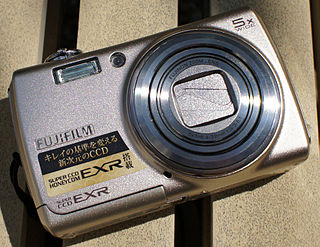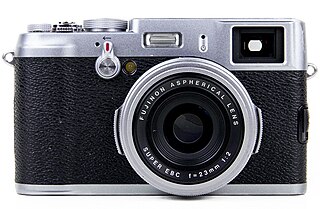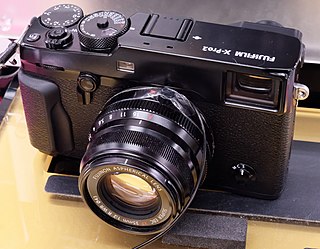
In photography, bokeh is the aesthetic quality of the blur produced in out-of-focus parts of an image, caused by circles of confusion. Bokeh has also been defined as "the way the lens renders out-of-focus points of light". Differences in lens aberrations and aperture shape cause very different bokeh effects. Some lens designs blur the image in a way that is pleasing to the eye, while others produce distracting or unpleasant blurring. Photographers may deliberately use a shallow focus technique to create images with prominent out-of-focus regions, accentuating their lens's bokeh.
Fujinon is a brand of optical lenses made by Fuji Photo Film Co., Ltd, now known as Fujifilm. Fujifilm's Fujinon lenses have been used by professional photographers and broadcast stations as well as cinematography. Fujifilm started manufacture of optical glass in its Odawara Factory in Japan in 1940, which was the start of the Fujinon brand. They were proud of their use of expensive Platinum crucibles to get the purest glass achievable at the time. Fujifilm also pioneered Electron Beam Coating (EBC) which according to Fujifilm, represented a new high in lens precision and performance. The EBC process was significantly different from other coating processes by the number of coating, the thinness of the coating, and the materials used for coating. Fujifilm claimed they were able to have as much as 14 layers of coating and used materials such as zirconium oxide, and cerium fluoride, which could not be used for coating in the conventional coating process. The first lens to offer the Electron Beam Coating was the EBC Fujinon 55mm F3.5 Macro in 1972. Light transmission for the coating was said to be 99.8%. EBC later evolved into Super-EBC and HT-EBC.

An autofocus optical system uses a sensor, a control system and a motor to focus on an automatically or manually selected point or area. An electronic rangefinder has a display instead of the motor; the adjustment of the optical system has to be done manually until indication. Autofocus methods are distinguished as active, passive or hybrid types.

A digital single-lens reflex camera is a digital camera that combines the optics and the mechanisms of a single-lens reflex camera with a solid-state image sensor and digitally records the images from the sensor.

Sigma Corporation is a Japanese company, manufacturing cameras, lenses, flashes and other photographic accessories. All Sigma products are produced in the company's own Aizu factory in Bandai, Fukushima, Japan. Although Sigma produces several camera models, the company is best known for producing high-quality lenses and other accessories that are compatible with the cameras produced by other companies.

In signal processing, apodization is the modification of the shape of a mathematical function. The function may represent an electrical signal, an optical transmission, or a mechanical structure. In optics, it is primarily used to remove Airy disks caused by diffraction around an intensity peak, improving the focus.

The FujifilmFinePix F series is a line of compact digital cameras that was known for its low-light performance in 2005, with relatively low image noise and natural colors even at high ISO settings. With its relatively large, but moderate resolution Super CCD sensors, it concentrated on image quality, and low-light shooting without flash, which was mostly restricted to prosumer models at the time.

Originally produced by Minolta, and currently produced by Sony, the STF 135mm f/2.8 [T4.5] is a photographic lens compatible with cameras using the Minolta AF and Sony α A-mount. STF stands for Smooth Trans Focus, in reference to its special optical system, which is intended to smooth the transition between the plane of focus and out-of-focus areas in the image. This is accomplished by the use of an apodization filter that provides the high-quality bokeh effect. The lens is not a soft-focus lens.

The Fujifilm FinePix S6500fd, known in the United States as S6000fd, was the first digital camera from Fujifilm with face detection technology. Also this camera has a different lens from its recent predecessors — a 28–300 mm equivalent 10.7x zoom, the same as the FinePix S9100/9600. The camera was announced on July 13, 2006.
The Fujica X-mount was a lens mount created by Fujifilm in the late 1970s and early 1980s for the new Fujica SLR lineup: AX-1, AX-3, AX-5, AX Multi, STX-1, STX-1N, STX-2, MPF105X, MPF105XN. It replaced the M42 screw mount used on their earlier SLRs.

The E-mount is a lens mount designed by Sony for their NEX and ILCE series of camcorders and mirrorless cameras. The E-mount supplements Sony's α mount, allowing the company to develop more compact imaging devices while maintaining compatibility with 35mm sensors. E-mount achieves this by:

The Fujifilm X-Pro1 is a mirrorless interchangeable-lens digital camera announced in January 2012 and launched in March 2012. It is part of Fujifilm's X-Series of cameras. In October 2012 Fujifilm released a very similar, yet smaller, camera named the X-E1. In January 2016 Fujifilm announced its successor, the X-Pro2.

The Fujifilm X-mount is a lens mount for Fujifilm interchangeable lens mirrorless cameras in its X-series, designed for 23.6mm x 15.6mm APS-C sensors.

The Fujifilm X100 is a series of digital compact cameras with a fixed prime lens. Originally part of the FinePix line, then becoming a member of the X series from Fujifilm, the X100 series includes the FinePix X100,X100S,X100T,X100F, and X100V. They each have a large image sensor and a 23 mm lens. All five cameras have received generally positive reviews.

The Smooth Trans Focus (STF) technology in photographic lenses uses an apodization filter to realize notably smooth bokeh with rounded out-of-focus highlights in both the foreground and background. This is accomplished by utilizing a concave neutral-gray tinted lens element next to the aperture blades as apodization filter, a technology originally invented by Minolta in the 1980s, and first implemented in a commercially available lens in 1999. In contrast to soft focus lenses, STF lenses render a perfectly sharp image in the focus plane.

The Fujinon XF 16mm F1.4 R WR is an interchangeable camera lens announced by Fujifilm on April 16, 2015. It has an unusually wide maximum aperture given its focal length, and is weather-sealed.

The Fujifilm XF 35mm F1.4 R is an interchangeable camera lens announced by Fujifilm on January 9, 2012. As of 2015, it remains one of the widest-aperture 35mm lenses available, giving a normal field of view on Fujifilm's APS-C format digital cameras.
The Fujinon XF 27mm F2.8 is an interchangeable camera pancake lens announced by Fujifilm on June 25, 2013. At 27 mm, it has a 35 mm equivalent focal length of 41 mm, making it a normal lens of maximum aperture f/2.8. The intended benefit of this lens is its extreme compact size, extending only 23 mm (0.91 in) from the flange, and light weight, only 77.3 g (2.73 oz), with the trade-off of having no aperture ring.

The Fujifilm X-Pro2 is a mirrorless interchangeable-lens digital camera announced in January 2016. It is part of Fujifilm's X-Series of cameras, the successor to the X-Pro1. Sales began on 3 March 2016.

The Fujifilm G-mount is a type of interchangeable lens mount designed by Fujifilm for use in the cameras of their Fujifilm GFX series. These cameras have interchangeable lenses. The respective lenses are designed for 43.8 mm x 32.9 mm medium format sensors.

















